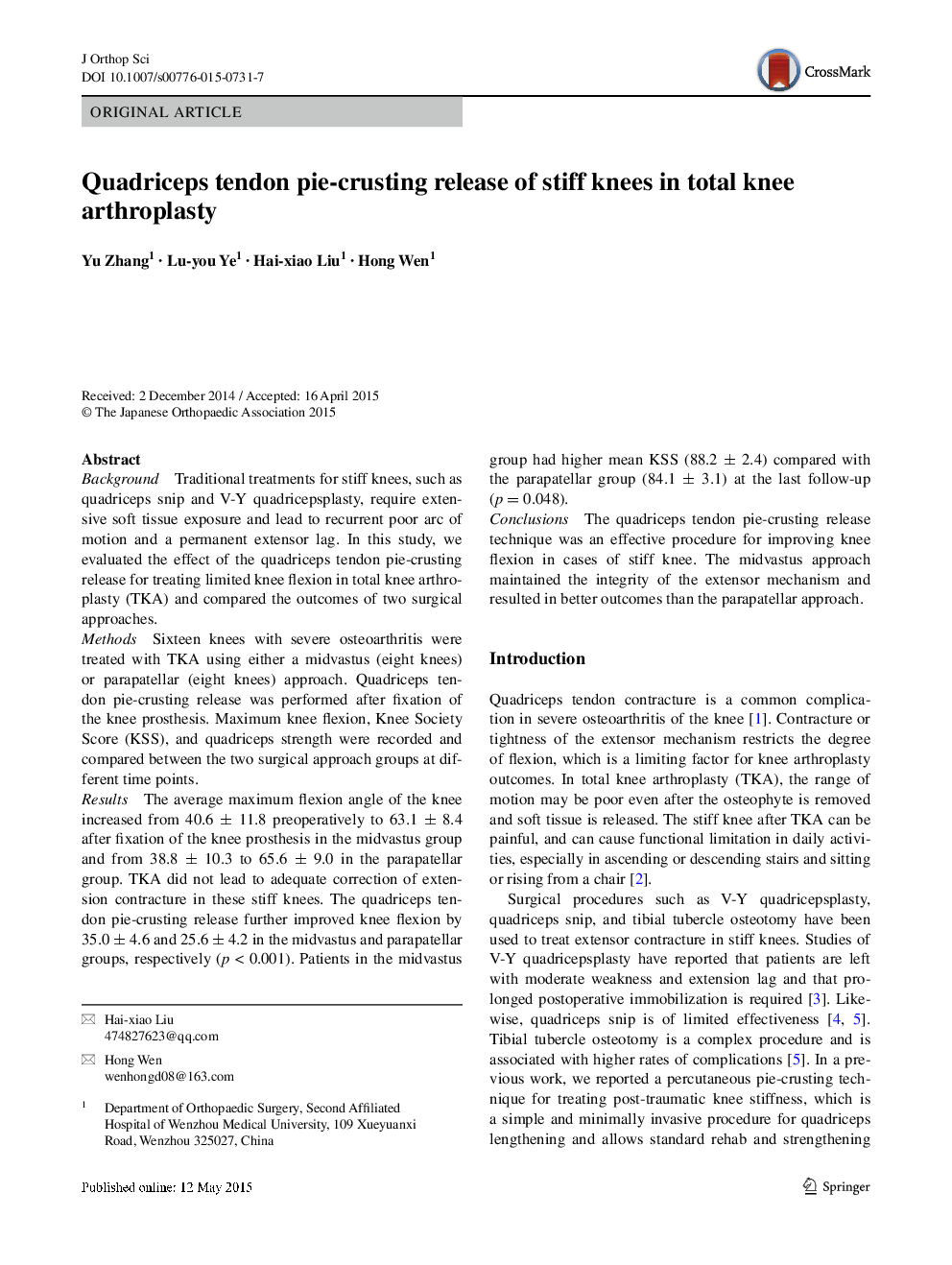| کد مقاله | کد نشریه | سال انتشار | مقاله انگلیسی | نسخه تمام متن |
|---|---|---|---|---|
| 10175061 | 1266830 | 2015 | 6 صفحه PDF | دانلود رایگان |
عنوان انگلیسی مقاله ISI
Quadriceps tendon pie-crusting release of stiff knees in total knee arthroplasty
ترجمه فارسی عنوان
آزادی زانوی سفتی در تاندون چهارگانه را به طور کلی در آرتروپلاستی زانو کامل قرار می دهد
دانلود مقاله + سفارش ترجمه
دانلود مقاله ISI انگلیسی
رایگان برای ایرانیان
موضوعات مرتبط
علوم پزشکی و سلامت
پزشکی و دندانپزشکی
ارتوپدی، پزشکی ورزشی و توانبخشی
چکیده انگلیسی
Background Traditional treatments for stiff knees, such as quadriceps snip and V-Y quadricepsplasty, require extensive soft tissue exposure and lead to recurrent poor arc of motion and a permanent extensor lag. In this study, we evaluated the effect of the quadriceps tendon pie-crusting release for treating limited knee flexion in total knee arthroplasty (TKA) and compared the outcomes of two surgical approaches. Methods Sixteen knees with severe osteoarthritis were treated with TKA using either a midvastus (eight knees) or parapatellar (eight knees) approach. Quadriceps tendon pie-crusting release was performed after fixation of the knee prosthesis. Maximum knee flexion, Knee Society Score (KSS), and quadriceps strength were recorded and compared between the two surgical approach groups at different time points. Results The average maximum flexion angle of the knee increased from 40.6 ± 11.8 preoperatively to 63.1 ± 8.4 after fixation of the knee prosthesis in the midvastus group and from 38.8 ± 10.3 to 65.6 ± 9.0 in the parapatellar group. TKA did not lead to adequate correction of extension contracture in these stiff knees. The quadriceps tendon pie-crusting release further improved knee flexion by 35.0 ± 4.6 and 25.6 ± 4.2 in the midvastus and parapatellar groups, respectively (p < 0.001). Patients in the midvastus group had higher mean KSS (88.2 ± 2.4) compared with the parapatellar group (84.1 ± 3.1) at the last follow-up (p = 0.048). Conclusions The quadriceps tendon pie-crusting release technique was an effective procedure for improving knee flexion in cases of stiff knee. The midvastus approach maintained the integrity of the extensor mechanism and resulted in better outcomes than the parapatellar approach.
ناشر
Database: Elsevier - ScienceDirect (ساینس دایرکت)
Journal: Journal of Orthopaedic Science - Volume 20, Issue 4, 2015, Pages 669-674
Journal: Journal of Orthopaedic Science - Volume 20, Issue 4, 2015, Pages 669-674
نویسندگان
Yu Zhang, Lu-you Ye, Hai-xiao Liu, Hong Wen,
